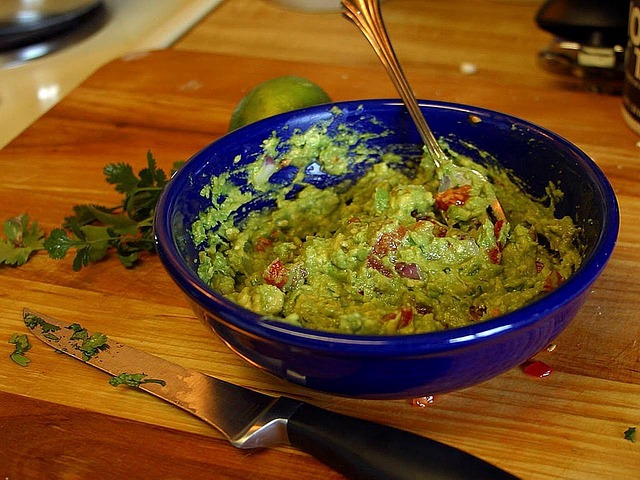Reportedly, although guacamole is enjoyed all year, it’s particularly popular on Cinco de Mayo and the Super Bowl.
Will you be making this classic dip for the big game this weekend?
Let’s find out where guacamole originated.
Definition: a dip of mashed avocado mixed with tomato, onion, and seasonings.
In exploring the history of guacamole, of course we must also investigate the origin of the avocado. As we can see from the definition, guacamole is ridiculously simple with few ingredients. The avocado is by far the most important element.
Avocados were first cultivated in Central America, as early as 7,000 BC. The exact country and area of origin is still debated.
From there, the avocado made its way north to Mexico, where the Aztecs turned the fruit into guacamole as early as the 1300s.
Avocados are very high in fat, which was a good thing for the Aztecs. They couldn’t always find high fat foods.
Other amazing information about avocados:
- They contain 60% more potassium than bananas.
- Over 70% of the oil is polyunsaturated – the good kind of fat.
- They’re one of only three fruits that have oil in their flesh.
- They have more fat than any other fruit.
- They have two to three times the amount of protein as other fruits.
- They contain almost 20 vitamins and minerals.
The word “avocado” comes from the Aztec word “ahuacatl” which means “testicle” or “testicle tree.” They named it such for its resemblance to the male genitalia. According to Wise Geek, women in Aztec villages were not allowed to leave the house during the avocado harvest for fear of sexual impurity.
Indeed, the Aztecs believed the avocado to be an aphrodisiac, a claim that has not been supported by science, and that does not appear to be utilized as such today.
The recipe, however, has pretty much stayed the same when it comes to guacamole. The Aztecs combined mashed avocados with onion, chiles, and tomatoes – today, the ingredients are the same, with cilantro, lime, or garlic sometimes added.
In the early 1500s, the Spaniards arrived in Mexico and fell in love with Aztec’s guacamole, and subsequently, the avocado.
The avocado did not preserve well when they attempted to take the fruit back to Spain. And, they were unable to produce them. The Spaniards tried to recreate guacamole with avocado substitutes, but of course, there aren’t really any.
My trusty Food Substitutions Bible lists only one possibility as a substitute for avocado: chayote squash, which I had not heart of until just now, but it looks like a cross between an avocado and a summer squash. In any case, I doubt the Spaniards had access to it. Or, that it could possibly beat the real thing.
In 1871, about 350 years after the Spaniards arrived in Mexico, the first avocado tree was planted and successfully cultivated in California. By the 1900s, avocados were a thriving crop, and they still are.
Today, California produces almost 90% of the country’s supply of avocados; 41% of California avocados are grown in San Diego county; and, 80% of California avocados are of the Haas variety, which is considered to the best kind for guacamole.
If you’d like to try guacamole at home, this recipe is by far the most popular and highly rated guacamole recipe on AllRecipes.com.
And if you’d really like to read into the science behind making the perfect guacamole, one of my favorite food writers, J. Kenji Lopez, writes on the topic here for the Food Lab via SeriousEats.com, with the recipe here.
How chunky or smooth you make your guac is up to you – but don’t forget, use few, good quality ingredients, including the ever important avocado!

Comments
One response to “Food history: guacamole (and the avocado)”
Guac (avocado) and mole (salsa)